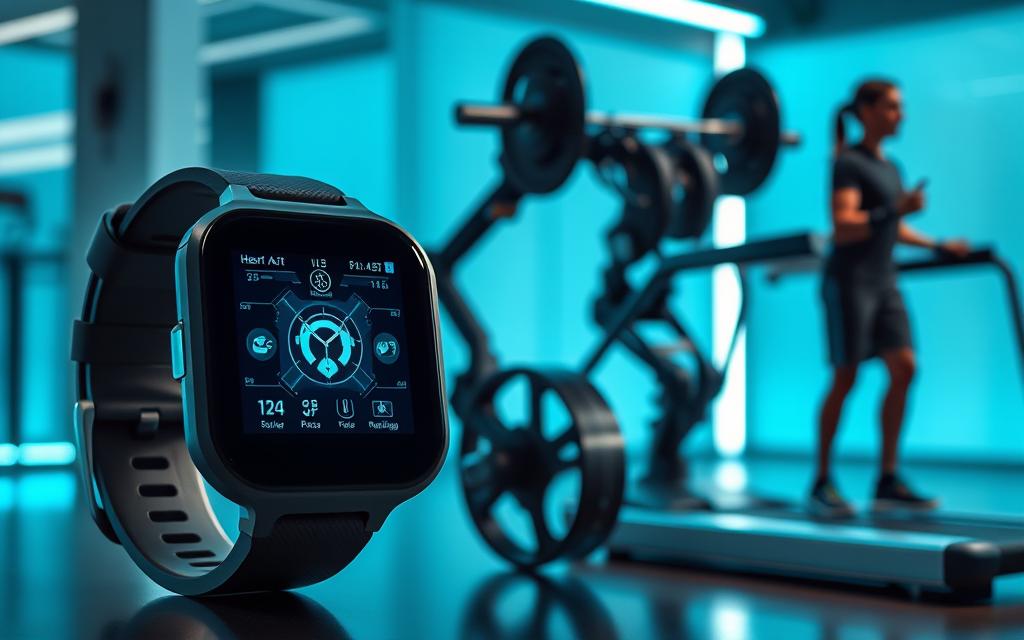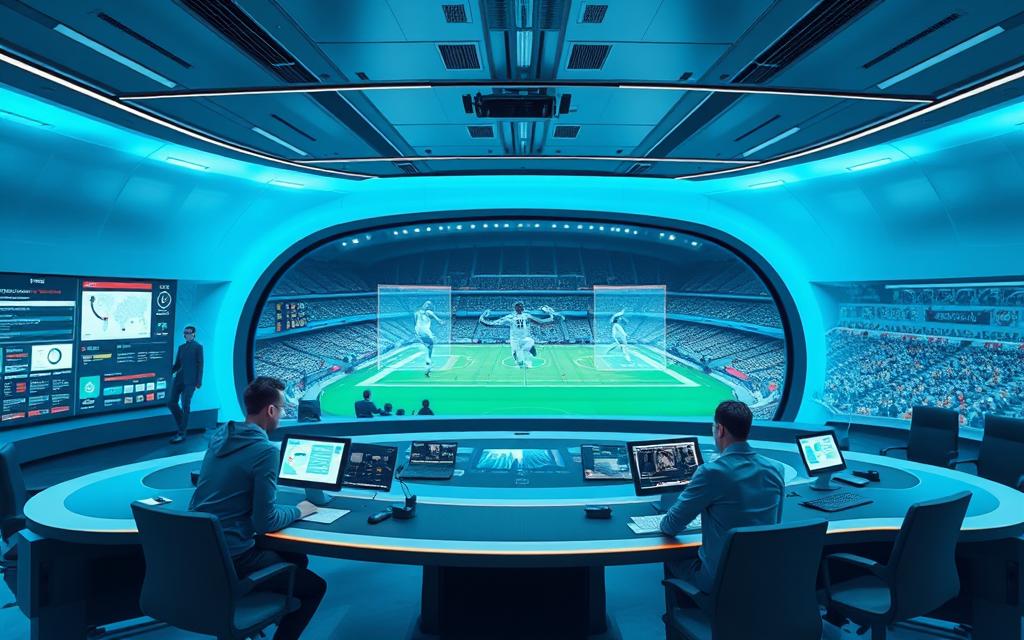In recent years, the role of digital tools in sports management has grown significantly. Teams now rely on advanced analytics and data visualization to make informed decisions. This shift from traditional methods to data-driven strategies has revolutionized the industry.
Modern tools like wearables and monitoring systems help optimize athlete performance. These devices track sleep, recovery, and daily effort, providing valuable insights. Coaches and players can now fine-tune their training regimens with precision.
Fan engagement has also seen a transformation. Streaming services like ESPN+ and Amazon Prime allow fans to access games from anywhere. This shift has enhanced the overall experience for supporters worldwide.
For more insights on this topic, explore how technology is changing the sports industry. The integration of these advancements continues to shape the future of sports management.
Introduction: The Role of Technology in Modern Sports Management
The landscape of managing athletic programs has evolved dramatically over the past decade. Traditional methods, once reliant on manual processes, have given way to data-driven strategies. This shift has redefined the industry, making digital tools essential for success.
Understanding the Shift in Sports Management
In earlier years, decisions were often based on intuition and experience. Today, advanced analytics and cloud computing provide actionable insights. For example, the NFL has improved decision-making speed by 78% using analytics platforms.
Artificial intelligence (AI) now plays a pivotal role in strategic planning. Teams leverage AI to analyze player performance and predict outcomes. This integration of technology ensures more accurate and efficient management.
Why Technology is Now a Fundamental Driver
Digital transformation has become a cornerstone of athletic business operations. A staggering 92% of organizations prioritize tech investments, recognizing its value. This focus has led to a 35% increase in revenue for many franchises.
DevOps practices have streamlined app development, enhancing team coordination. Wearables and monitoring systems provide real-time data, optimizing training and recovery. These advancements highlight the economic impact of tech adoption in the industry.
| Aspect | Traditional Methods | Modern Practices |
|---|---|---|
| Decision-Making | Based on intuition | Data-driven insights |
| Training | Manual tracking | Wearable technology |
| Revenue Growth | Limited by manual processes | 35% increase with tech adoption |
The Evolution of Sports Management Through Technology
The transformation of athletic programs has been shaped by digital advancements. From manual processes to sophisticated systems, the field has undergone a remarkable shift. This evolution has not only improved efficiency but also redefined the way organizations operate.
From Traditional Methods to Digital Transformation
In the past, decisions relied heavily on intuition and experience. Today, data-driven strategies dominate the world of athletic management. For instance, the introduction of VAR in the 2018 FIFA World Cup marked a significant milestone. This innovation ensured fair play and reduced errors during critical moments.
Similarly, the NHL Draft app in 2021 cut selection errors by 62%. These examples highlight the growing reliance on digital tools. The transition from paper scouting to advanced systems like Statcast has streamlined operations across leagues.
Key Milestones in Sports Technology
The journey of innovation in athletic management includes several pivotal moments:
- 1990s: Introduction of GPS trackers for player monitoring.
- 2018: First VAR implementation in the FIFA World Cup.
- 2021: NHL Draft app reduced selection errors significantly.
- 2023: AI coaches began assisting in strategic planning.
These advancements have not only enhanced performance but also opened new avenues for marketing and fan engagement. Emerging markets, particularly in esports, are leveraging these technologies to create immersive experiences.
Delayed adoption of these tools can have financial repercussions. Teams that embrace digital transformation often see a boost in revenue. The future of athletic management lies in the seamless integration of these innovations, ensuring sustained growth and success.
How Has Technology Changed How Sports Teams Are Managed?
The adoption of digital innovations has reshaped athletic operations globally. These advancements have streamlined processes, improved decision-making, and enhanced overall efficiency. Two key areas driving this transformation are the integration of data analytics and the enhancement of communication and collaboration.
The Integration of Data Analytics
Real-time data has become a game-changer for coaching staff. By analyzing over 10,000 data points per game, basketball teams can make precise adjustments. This approach has reduced coaching errors by 40%, ensuring more accurate strategies.
Rugby squads also benefit from encrypted messaging systems for injury reporting. This ensures quick and secure access to critical information, minimizing delays in treatment. The impact of these tools is evident in the improved efficiency of roster management compared to 2013.
Enhancing Communication and Collaboration
Teams using platforms like Slack for Sports have seen a 50% faster update rate for playbooks. This streamlined communication allows coaches and players to stay aligned, improving overall skills and performance.
However, cybersecurity challenges remain a concern for team communication platforms. Multilingual AI translation tools are also gaining traction, helping international coaching staff collaborate seamlessly. These innovations highlight the importance of tracking and adapting to new technologies.
Data Analytics: The Backbone of Modern Sports Management
Data analytics now plays a pivotal role in shaping the strategies of athletic programs. By leveraging advanced software, teams can gather and interpret vast amounts of information to optimize performance and decision-making. This approach has become essential for staying competitive in today’s fast-paced environment.

Real-Time Performance Tracking
Modern tools enable real-time monitoring of athletes, providing insights into every aspect of their performance. Wearables generate up to 25GB of data per athlete daily, tracking metrics like heart rate, speed, and recovery. This information helps coaches make immediate adjustments during games or training sessions.
For example, baseball teams use spin rate analysis to refine pitching strategies. This technique has revolutionized the way pitchers approach their craft, leading to more effective gameplay. Similarly, IoT sensors in stadiums adjust environmental factors like lighting and temperature, ensuring optimal conditions for players.
Predictive Analytics for Strategic Decisions
Predictive models are transforming how teams plan for the future. The NBA’s Second Spectrum predicts plays with 89% accuracy, giving coaches a competitive edge. Machine learning algorithms also assist in draft pick success prediction, helping teams identify top talent early.
Financial analytics play a crucial role in salary cap optimization, ensuring teams stay within budget while maximizing player value. However, ethical considerations around player biometric data usage remain a topic of discussion. Balancing innovation with privacy is key to maintaining trust.
- Baseball spin rate analysis revolutionizing pitching strategies.
- Machine learning models for draft pick success prediction.
- Salary cap optimization through financial analytics.
- Ethical considerations in player biometric data usage.
- Integration with stadium IoT sensors for environmental adjustments.
Wearable Technology: Revolutionizing Athlete Performance
Wearable devices have become essential tools for optimizing athletic performance. These gadgets provide real-time insights into health, fitness, and recovery, enabling athletes to push their limits safely. From GPS vests to smart mouthguards, the integration of sensors has transformed how athletes train and recover.
Monitoring Health and Fitness Metrics
Modern wearables track a wide range of metrics, from heart rate to acceleration. Soccer GPS vests, for example, measure acceleration and deceleration loads, helping coaches tailor training programs. WHOOP straps, used by 92% of Premier League teams, optimize sleep patterns, ensuring athletes are well-rested for peak performance.
Customized hydration algorithms based on sweat analysis further enhance performance. These innovations allow athletes to maintain optimal hydration levels, reducing fatigue and improving endurance. The data collected by these devices is invaluable for long-term career planning.
Preventing Injuries Through Data Insights
Injury prevention has seen significant advancements with wearable technology. Catapult Sports wearables have reduced ACL injuries by 33%, thanks to real-time monitoring of movement patterns. Smart mouthguards detect concussion risks instantly, allowing for immediate medical intervention.
FDA-approved recovery technologies, like hyperbaric chambers, accelerate healing and reduce downtime. These tools not only prevent injuries but also ensure athletes recover faster, maintaining their competitive edge.
| Aspect | Traditional Methods | Modern Practices |
|---|---|---|
| Injury Prevention | Manual observation | Real-time monitoring with wearables |
| Recovery | Rest and basic physiotherapy | FDA-approved tech like hyperbaric chambers |
| Performance Tracking | Manual logging | GPS vests and WHOOP straps |
Communication Tools: Streamlining Team Operations
Effective communication tools have become indispensable in modern athletic operations. From scheduling to playbook distribution, these innovations ensure seamless coordination. Teams now rely on advanced software to enhance efficiency and reduce errors.
Microsoft Teams for Sports has reduced scheduling conflicts by 65%, proving its value in team coordination. Virtual reality draft combines have saved the NFL $4.2 million in travel costs, showcasing the financial benefits of remote collaboration.
Mobile Apps for Team Coordination
Custom apps are transforming how teams distribute playbooks and manage schedules. These tools provide secure access to critical information, ensuring everyone stays on the same page. AI-powered calendar management simplifies complex tournament schedules, reducing the risk of missed events.
Secure video conferencing platforms enable international scouting without the need for travel. This approach not only saves time but also expands the talent pool. Language processing tools facilitate global fan interactions, enhancing experiences for supporters worldwide.
Virtual Meetings and Remote Collaboration
Virtual meetings have become a cornerstone of remote collaboration. Teams use platforms like Zoom and Slack to conduct strategy sessions and share updates. These tools ensure that coaches and players can collaborate effectively, regardless of location.
Digital twin technology is revolutionizing facility management by creating virtual replicas of stadiums. This innovation allows teams to simulate scenarios and optimize operations. The integration of these tools highlights the growing role of media in athletic management.
| Aspect | Traditional Methods | Modern Practices |
|---|---|---|
| Scheduling | Manual coordination | AI-powered calendar management |
| Playbook Distribution | Printed copies | Custom mobile apps |
| Scouting | In-person visits | Secure video conferencing |
| Facility Management | Physical inspections | Digital twin technology |
Fan Engagement: Leveraging Technology for Better Experiences
The way fans connect with their favorite teams has been transformed by digital innovations. From social media to immersive technologies, these tools are reshaping how supporters interact with the games they love. This shift has not only deepened fan loyalty but also opened new revenue streams for organizations.
Social Media and Digital Platforms
Social media platforms like Instagram and Twitter have become essential for fan engagement. Teams use these channels to share behind-the-scenes content, live updates, and exclusive interviews. For example, Snapchat filters have generated $3.5 million in team revenue, showcasing the financial potential of creative marketing.
Blockchain-based NFT ticket upgrades are another innovative approach. These digital collectibles offer fans unique perks, such as VIP access or personalized memorabilia. Real-time betting integration through app APIs has also gained traction, adding an interactive layer to the viewing experience.
Virtual and Augmented Reality in Fan Interaction
Augmented reality (AR) features have boosted merchandise sales by 28%, as fans enjoy immersive shopping experiences. Meta Quest partnerships allow supporters to explore virtual locker rooms, bringing them closer to their favorite players. These technologies create memorable moments that enhance fan loyalty.
Personalized highlight reels, powered by AI editing tools, are another example of how virtual reality is changing the game. Fans can relive their favorite moments in stunning detail, making every match feel personal. The NFL’s Next Gen Stats app, which increased viewership by 19%, highlights the growing importance of these innovations.
Video Analysis: Enhancing Training and Strategy
Video analysis has become a cornerstone of modern athletic development. Teams now rely on advanced systems to break down every aspect of performance. From refining techniques to studying opponents, these tools provide actionable insights that drive success.
High-Speed Cameras for Technique Improvement
High-speed cameras capture every detail of an athlete’s movement. For example, tennis players using SwingVision have improved serve accuracy by 18%. These tools allow coaches to identify subtle flaws and make precise adjustments.
360-degree camera arrays are also gaining popularity. They provide a complete view of spatial awareness during training. Volleyball teams use motion capture to analyze jump mechanics, ensuring optimal form and reducing injury risks.
Analyzing Opponents for Competitive Advantage
Studying opponents is now more efficient with AI-powered software. Hudl Sportscode cuts film review time by 70%, giving teams a strategic edge. AI pattern recognition identifies playcalling tendencies, helping coaches prepare for upcoming matches.
Drone technology offers aerial views of the field, revealing hidden patterns in gameplay. However, privacy regulations must be considered when using opponent footage. Balancing innovation with ethics ensures fair and effective analysis.
Instant Replay and VAR: Ensuring Fair Play
Instant replay and VAR have become critical tools in ensuring fairness in modern games. These systems reduce human error and provide accurate decisions, enhancing the integrity of matches. The role of VAR in modern sports is pivotal, as it supports referees in making informed calls.
The impact of these systems is undeniable. For example, VAR reduces controversial calls by 72% in MLS, ensuring smoother gameplay. Hawk-Eye, a leading software, processes 5,000 data points per second, offering precise insights into every move.
The Role of VAR in Modern Sports
VAR has redefined officiating by providing real-time feedback to referees. It helps in reviewing critical moments like goals, penalties, and red cards. This technology ensures that decisions are based on concrete evidence rather than subjective judgment.
Across the world, leagues are adopting VAR to maintain fairness. Soccer goal-line technology, for instance, has set new accuracy standards. Similarly, chip-enabled balls in World Cup tournaments provide instant feedback on goal validity.
How Instant Replay Has Changed Refereeing
Instant replay has transformed how referees make decisions. Advanced software processes data instantly, allowing officials to review plays within seconds. This system minimizes errors and ensures transparency.
Training programs for tech-assisted officiating are also gaining traction. These programs help referees adapt to new systems, improving their decision-making skills. Fan sentiment analysis on review decisions further highlights the growing acceptance of these technologies.
- Soccer goal-line technology accuracy standards.
- NBA’s Last Two Minute Report system.
- Chip-enabled balls in World Cup tournaments.
- Fan sentiment analysis on review decisions.
- Training programs for tech-assisted officiating.
| Aspect | Traditional Refereeing | Modern Refereeing |
|---|---|---|
| Decision Accuracy | Reliant on human judgment | Supported by VAR and instant replay |
| Review Speed | Manual reviews took minutes | Instant feedback with advanced software |
| Fan Trust | Lower due to frequent errors | Higher with transparent decision-making |
Innovative Sports Equipment: Boosting Performance
Innovative equipment is reshaping the way athletes perform and compete. From advanced materials to cutting-edge designs, these tools are setting new standards in efficiency and safety. The integration of sensors and smart features has transformed traditional gear into powerful performance enhancers.

Advanced Materials and Designs
Modern sports equipment leverages groundbreaking materials to improve performance. For example, Nike’s Vaporfly shoes have been shown to reduce marathon times by 4%. These shoes use lightweight foam and carbon fiber plates to maximize energy return.
Temperature-regulating fabrics in NHL uniforms ensure players stay comfortable during intense games. Impact-absorbing turf technology reduces injury risks, making it safer for athletes to train and compete. These advancements highlight the importance of material development in sports.
Technology-Driven Gear for Athletes
Smart devices are revolutionizing athletic performance. Cricket bats equipped with embedded sensors have increased scoring by 11%. These tools provide real-time feedback, helping players refine their techniques.
Custom 3D-printed insoles offer personalized support, enhancing comfort and reducing fatigue. Equipment certification processes ensure new tech meets safety standards, protecting athletes throughout their career. Sustainability in gear manufacturing is also gaining traction, with eco-friendly materials becoming a priority.
- Lightweight carbon fiber in running shoes.
- Smart cricket bats with embedded sensors.
- Eco-friendly materials in manufacturing.
- Certification processes for new equipment.
Sports Broadcasting: Transforming the Viewing Experience
Sports broadcasting has undergone a dramatic transformation in recent years. Advanced tools and platforms now deliver immersive experiences to fans worldwide. This shift has not only enhanced engagement but also opened new revenue streams for the business.
High-Definition and Multi-Angle Cameras
High-definition cameras have set new standards in sports coverage. 8K broadcasts reach 89 countries simultaneously, offering crystal-clear visuals. Multi-angle systems like SpiderCam provide dynamic views, capturing every moment from unique perspectives.
Player mic’d audio feeds add a premium layer to broadcasts. Fans can hear on-field conversations, bringing them closer to the action. Augmented reality graphics explain complex rules, making the game more accessible to newcomers.
Live Streaming and Global Accessibility
Live streaming platforms like Twitch have expanded the reach of sports. Young NBA viewership increased by 34% thanks to these platforms. Regional blackout solutions, using VPN detection, ensure fans can access games regardless of location.
Second-screen app synchronization enhances the viewing experience. Fans can access real-time stats, replays, and social media interactions while watching the game. This integration creates a more engaging and interactive environment.
| Aspect | Traditional Broadcasting | Modern Broadcasting |
|---|---|---|
| Visual Quality | Standard definition | 8K resolution |
| Viewing Angles | Limited camera positions | SpiderCam and multi-angle systems |
| Global Reach | Localized broadcasts | Live streaming on platforms like Twitch |
| Fan Interaction | Passive viewing | Second-screen app synchronization |
Injury Prevention and Rehabilitation: Technology’s Role
The integration of advanced technologies has significantly improved injury prevention and rehabilitation in athletics. These innovations provide precise diagnostics and faster healing methods, ensuring athletes stay at their peak performance.

Advanced Imaging Techniques for Diagnosis
Modern imaging tools like MRI and CT scans offer detailed insights into injuries. For example, MLS reduced muscle injuries by 41% using Prevent, a system that analyzes movement patterns. Force plate analysis corrects gait issues, preventing long-term damage.
Hydration monitoring IV systems ensure athletes maintain optimal fluid levels during recovery. These devices track hydration in real-time, reducing the risk of dehydration-related complications.
Recovery Technologies for Faster Healing
Cryotherapy has become a game-changer, cutting recovery time by 37%. This method uses extreme cold to reduce inflammation and speed up healing. VR cognitive therapy aids concussion recovery by retraining the brain through immersive exercises.
Biometric passport systems streamline medical clearance, ensuring athletes are fit to return. Partnerships with regenerative medicine companies bring cutting-edge treatments like stem cell therapy to the forefront.
| Aspect | Traditional Methods | Modern Practices |
|---|---|---|
| Diagnosis | Manual examination | Advanced imaging like MRI |
| Recovery | Rest and basic physiotherapy | Cryotherapy and VR therapy |
| Monitoring | Manual hydration checks | Hydration monitoring IV systems |
AI and Machine Learning: The Future of Sports Management
Artificial intelligence is reshaping the way athletic programs operate. With predictive analytics and machine learning, teams can now make more informed decisions. These technologies are not just enhancing performance but also transforming fan engagement.
Predictive Analytics for Injury Prevention
AI predicts NBA injuries with 82% accuracy, offering valuable insights for teams. By analyzing player data, coaches can identify risk factors early. This proactive approach helps in reducing downtime and maintaining peak performance.
Natural language processing is also being used for scouting reports. It automates the analysis of player performance, saving time and improving accuracy. Machine vision aids in talent identification, ensuring teams find the best players.
AI-Driven Fan Engagement Strategies
Chatbots handle 63% of fan inquiries, providing instant support. These AI tools enhance the fan experience by offering quick and accurate responses. Dynamic pricing algorithms optimize ticket sales, ensuring maximum revenue.
Generative AI creates personalized content, making fans feel more connected. Ethical AI governance frameworks ensure these technologies are used responsibly. These strategies not only boost engagement but also build long-term loyalty.
| Aspect | Traditional Methods | AI-Driven Methods |
|---|---|---|
| Injury Prevention | Manual analysis | Predictive analytics |
| Fan Engagement | Standard responses | Chatbots and AI content |
| Revenue Optimization | Fixed pricing | Dynamic pricing algorithms |
“AI is not just a tool; it’s a game-changer in how we manage and engage with sports.”
- Natural language processing for scouting reports.
- Dynamic pricing algorithms for ticket sales.
- Generative AI for personalized content creation.
- Ethical AI governance frameworks.
- Machine vision for talent identification.
Case Studies: Successful Technology Integration in Sports
Modern athletic programs are leveraging cutting-edge tools to enhance performance and streamline operations. These advancements have not only improved efficiency but also redefined how organizations manage their business processes.

NHL Draft Experience Modernization
The NHL Draft app has revolutionized the selection process, reducing errors by 62%. This integration of technology ensures a smoother and more accurate draft experience. Key features include:
- Hybrid cloud infrastructure for seamless data access.
- Broadcast partner API integrations for real-time updates.
- Scouting database security protocols to protect sensitive information.
NFL’s Next Gen Stats App
The NFL’s Next Gen Stats app has significantly increased fan engagement, with a 44% boost in app usage. This tool provides detailed analytics and real-time stats, enhancing the viewing experience. Highlights include:
- User experience testing methodologies for continuous improvement.
- ROI analysis of tech investments to ensure cost-effectiveness.
| Aspect | NHL Draft App | Next Gen Stats App |
|---|---|---|
| Error Reduction | 62% | N/A |
| Engagement Increase | N/A | 44% |
| Key Features | Hybrid cloud, API integrations, security protocols | User experience testing, ROI analysis |
Challenges and Considerations in Adopting Sports Technology
The integration of advanced tools in athletic management brings both opportunities and challenges. While these innovations enhance efficiency, they also introduce complexities that require careful navigation. Two critical areas of concern are data security and the balance between modern and traditional methods.
Data Security and Privacy Concerns
With the rise of digital tools, data breaches in the sports industry increased by 57% in 2022. Protecting sensitive player information is now a top priority for organizations. GDPR compliance ensures that data management practices meet stringent privacy standards.
Legacy systems often struggle to integrate with new technologies, creating vulnerabilities. Disaster recovery planning is essential to safeguard against potential breaches. These measures not only protect data but also build trust among athletes and stakeholders.
Balancing Technology with Traditional Methods
While technology offers significant advantages, 68% of coaches resist over-automation. Cultural resistance from veteran staff can hinder the adoption of new tools. Striking a balance between innovation and tradition is crucial for seamless integration.
Cost-benefit analysis frameworks help organizations evaluate the impact of new technologies. This approach ensures that investments align with long-term goals. By respecting traditional methods while embracing innovation, teams can optimize their career development strategies.
Conclusion: The Future of Sports Management with Technology
The future of athletic management is being reshaped by emerging technologies. Quantum computing is set to revolutionize play analysis, offering deeper insights into strategies and performance. Ethical considerations, such as genetic performance testing, will play a crucial role in maintaining fairness and integrity in the field.
Global standardization of sports tech regulations will ensure consistency and fairness across the world. This will also open up new career opportunities in sports technology, making it an exciting business to be part of in the coming years.
To stay ahead, organizations should adopt tech adoption roadmaps that balance innovation with tradition. By doing so, they can maximize the benefits of new tools while respecting the core values of the sport.







